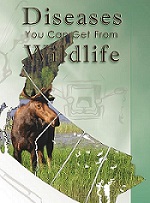Wildlife Health Matters
To care for B.C.’s wild animal populations, we need to take three main steps.
These steps are:
Step 1: Assess
We need to know how healthy wild animal populations are right now.
Understanding and measuring wildlife health, and developing a way to set baseline indicators of health is a "team sport". Many of the tools and approaches used to assess wildlife health fall outside of traditional animal health evaluations.
Step 2: Monitor
We need to keep track of changes to wildlife health —a process we call monitoring.
The process of monitoring can help identify changes in risk factors, which can include:
- Changes in land use
- Climate change, or
- New invasive species
Once we know where the greatest risks are, we can place resources to where they are in need the most. Before wildlife health problems or diseases sets in.
Step 3: Sustain
We need to do what we can to keep wildlife populations healthy.
Wild animals are exposed to many dangers and stresses that can impact wildlife health. Wild animals can often cope if they have enough reserves (such as a bit more fat at the start of winter) and if the stressors are not too many. We can protect wildlife by reducing the stresses and dangers they face by:
-
Managing interactions between domestic and wild animals
-
Reducing or eliminating contaminants
-
Managing the movement or introduction of species
Cumulative effects impacting wildlife
Cumulative effects are the combined factors that affect both the environment and wildlife. These factors are often human activities or human-caused events, such as:
- Industrialization
- Urbanization, and
- Climate change
Cumulative effects can make wildlife less resilient to stress, and can change their ability to access the resources they need to survive and reproduce. Differences in the health of individual animals or in entire populations could reveal different cumulative effects. Tracking wildlife health information can help to decide how to manage wildlife health.
These efforts will help to:
-
Reduce risk to vulnerable populations,
-
Identify ecosystems where cumulative effects are more prevalent
-
Signal emerging issues or risks to human health
Report animals
Stay Healthy Around Wildlife
Read the booklet Diseases You Can Get From Wildlife (PDF, 8.6MB)
Learn about Safe Game Meat Handling (PDF, 149 KB)
Contact information
For wildlife-human interactions where public safety may be at risk call the Report All Poachers and Polluters (RAPP) line:
For wildlife health inquiries or reports:
Wildlife Health Office
250 751-7246
250 751-7246

